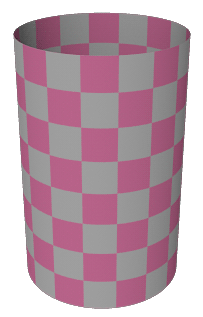Before we begin, let us differentiate between two things:
- The shape of a sphere,
- and the topology of a sphere.
A NURBS surface can make the shape of a sphere. In a typical configuration, it will be 'open' at the poles. That is the mathematical function of the surface does not wrap over the pole in that it is not a true sphere (it has the shape of a sphere). Topologically the sphere is in this typical configuration a cylinder.
It is possible to leave the other direction open too in which case it is topologically a plane. Several CAD applications choose this approach. A torus is also possible if you allow a thin no volume sliver at the center of your sphere.
Image 1: Turning cylinder to sphere. Note this is not a topological sphere it is still a cylinder as the top is open (even though infinitesimally small).
Is the sphere homeomorphic to one of the above surfaces?
No, but you can still have a spherical shape even if it does not satisfy the topology condition of mathematics.
Why only 3 topological families?
Simply, a NURBS surface has only 4 possible configurations of wrapping around the parameter space:
- It does not wrap at all. Topology: Plane.
- It wraps around the U direction. Topology: Cylinder.
- It wraps around V direction. Same as above. Topology: Cylinder.
- It wraps around both U and V. Topology: Torus.
A wrap is always periodic so it goes from - direction to + direction. It can not arbitrarily connect (on a mathematical level).
